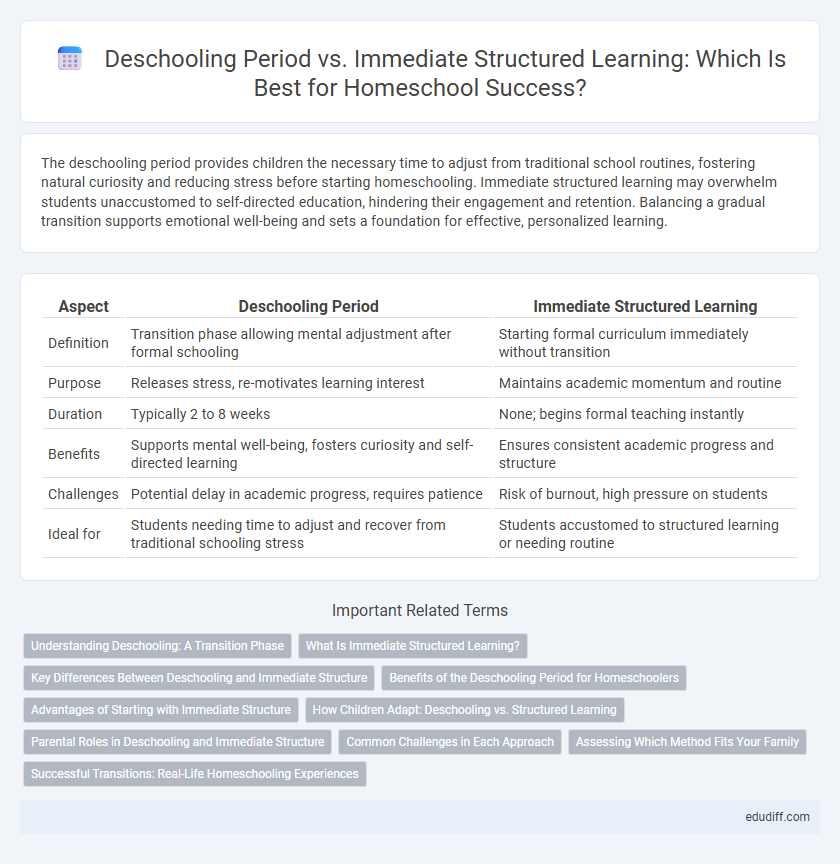The deschooling period provides children the necessary time to adjust from traditional school routines, fostering natural curiosity and reducing stress before starting homeschooling. Immediate structured learning may overwhelm students unaccustomed to self-directed education, hindering their engagement and retention. Balancing a gradual transition supports emotional well-being and sets a foundation for effective, personalized learning.
Table of Comparison
| Aspect | Deschooling Period | Immediate Structured Learning |
|---|---|---|
| Definition | Transition phase allowing mental adjustment after formal schooling | Starting formal curriculum immediately without transition |
| Purpose | Releases stress, re-motivates learning interest | Maintains academic momentum and routine |
| Duration | Typically 2 to 8 weeks | None; begins formal teaching instantly |
| Benefits | Supports mental well-being, fosters curiosity and self-directed learning | Ensures consistent academic progress and structure |
| Challenges | Potential delay in academic progress, requires patience | Risk of burnout, high pressure on students |
| Ideal for | Students needing time to adjust and recover from traditional schooling stress | Students accustomed to structured learning or needing routine |
Understanding Deschooling: A Transition Phase
Understanding deschooling is essential for a smooth transition from traditional schooling to homeschooling, allowing children time to decompress from rigid academic schedules and rediscover intrinsic motivation for learning. This period typically lasts several weeks to months, during which families focus on reestablishing trust and exploring interests without the pressure of formal lessons. Immediate structured learning can overwhelm students, whereas deschooling supports emotional adjustment and fosters a more personalized, effective homeschooling experience.
What Is Immediate Structured Learning?
Immediate structured learning in homeschooling refers to starting a formal, organized curriculum right after transitioning from traditional school, emphasizing scheduled lessons and predefined educational goals. This approach contrasts with the deschooling period, where children are given time to adjust away from conventional school methods before beginning structured studies. Advocates argue that immediate structured learning ensures continuity and maintains academic discipline, potentially minimizing gaps in knowledge acquisition.
Key Differences Between Deschooling and Immediate Structure
The deschooling period allows children to gradually transition from traditional schooling by freeing them from rigid schedules and academic pressures, fostering natural curiosity and emotional adjustment. Immediate structured learning imposes a fixed curriculum and daily routines from the start, emphasizing measurable progress and consistent academic engagement. Key differences lie in flexibility, emotional readiness, and the balance between autonomy and structured accountability during the homeschooling transition.
Benefits of the Deschooling Period for Homeschoolers
The deschooling period in homeschooling allows students to transition smoothly from traditional classroom environments, reducing stress and rebuilding intrinsic motivation for learning. This phase helps children rediscover curiosity and develop self-directed learning skills, leading to a deeper understanding and retention of knowledge. Emphasizing deschooling promotes emotional well-being and fosters a personalized educational experience tailored to each child's unique pace and interests.
Advantages of Starting with Immediate Structure
Starting with immediate structured learning in homeschooling provides clear routines and consistent expectations, which can enhance focus and accelerate academic progress. This approach benefits students who thrive in organized environments by fostering discipline and reducing the potential confusion of transitioning from traditional school settings. Immediate structure also supports efficient curriculum delivery, ensuring comprehensive coverage of essential subjects from the outset.
How Children Adapt: Deschooling vs. Structured Learning
Children adapt to homeschooling differently during the deschooling period versus immediate structured learning; deschooling allows gradual adjustment by reducing traditional school pressures, fostering natural curiosity and self-directed learning. Immediate structured learning introduces a defined schedule and curricula early on, promoting discipline and routine but may cause initial resistance or stress as children transition. Understanding these adaptation processes helps tailor homeschooling strategies to individual learning styles and emotional needs, optimizing educational outcomes.
Parental Roles in Deschooling and Immediate Structure
Parental roles during the deschooling period emphasize creating a nurturing environment that allows children to adjust from traditional school routines to more flexible, learner-centered approaches, fostering autonomy and curiosity. In contrast, immediate structured learning requires parents to adopt roles akin to traditional teachers, implementing consistent schedules, curriculum plans, and direct instruction to maintain academic progress. Effective homeschooling balances these roles by recognizing the child's readiness for formal learning while providing emotional support and tailored educational guidance.
Common Challenges in Each Approach
The deschooling period often presents challenges such as child frustration, lack of routine, and parental uncertainty about academic expectations, while immediate structured learning can lead to overwhelming stress, reduced creativity, and resistance to strict schedules. Families adopting deschooling must navigate the balance between freedom and informal skill-building, whereas those choosing immediate structure face difficulties in maintaining consistent engagement and adapting traditional curricula to individual learning paces. Effective homeschooling requires addressing these unique stressors by integrating flexibility with gradual academic goals to foster both emotional well-being and educational progress.
Assessing Which Method Fits Your Family
The deschooling period allows children to adjust naturally from traditional schooling to homeschooling, promoting emotional well-being and intrinsic motivation while preventing burnout. Immediate structured learning suits families seeking clear routines and measurable progress, emphasizing consistency and academic rigor. Assessing family dynamics, children's learning styles, and emotional readiness helps determine which approach optimizes educational outcomes and holistic development.
Successful Transitions: Real-Life Homeschooling Experiences
Successful transitions from traditional schooling to homeschooling often involve a deschooling period that allows children to adjust emotionally and mentally, fostering a natural curiosity without the pressures of immediate structured learning. Real-life homeschooling experiences reveal that families who implement deschooling report smoother adaptation, increased enthusiasm for learning, and deeper family connections. In contrast, jumping straight into a rigid curriculum can lead to resistance, burnout, and diminished educational engagement.
Deschooling Period vs Immediate Structured Learning Infographic

 edudiff.com
edudiff.com